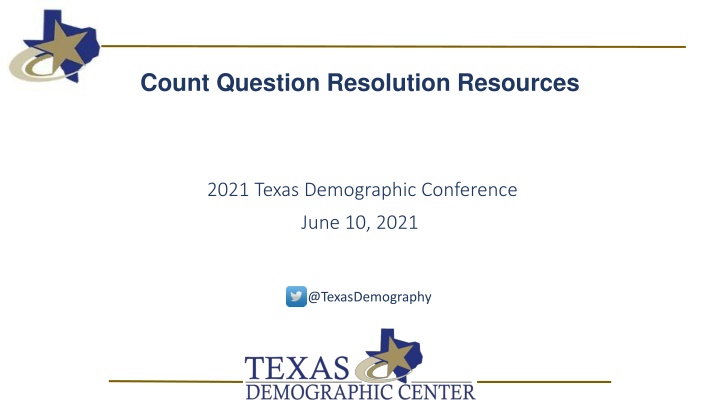
Insights from Texas Demographic Conference 2021 & Census Resources
Explore the highlights from the Texas Demographic Conference in June 2021, focusing on the Count Question Resolution Program for housing and population census. Learn about boundary corrections, living quarters geocoding, and census data comparison. Discover how local data, TNRIS resources, and appraisal districts contribute to accurate demographic insights and address challenges in census reporting.
Download Presentation

Please find below an Image/Link to download the presentation.
The content on the website is provided AS IS for your information and personal use only. It may not be sold, licensed, or shared on other websites without obtaining consent from the author. If you encounter any issues during the download, it is possible that the publisher has removed the file from their server.
You are allowed to download the files provided on this website for personal or commercial use, subject to the condition that they are used lawfully. All files are the property of their respective owners.
The content on the website is provided AS IS for your information and personal use only. It may not be sold, licensed, or shared on other websites without obtaining consent from the author.
E N D
Presentation Transcript
Count Question Resolution Resources 2021 Texas Demographic Conference June 10, 2021 @TexasDemography
Count Question Resolution Program The CQR operation accepts requests for review of the 2020 census housing & population counts based on two types of cases: boundary and/or living quarters count. Boundary Correct inaccurate reporting or recording of boundaries legally in effect on January 1, 2020. Living Quarters Geocoding Correct the placement of living quarters and associated population within the correct governmental unit boundaries and 2020 census tabulation blocks. Coverage Add or delete specific living quarters and people associated with them, identified during the census process, but erroneously included as duplicates or excluded due to processing errors. 2
Census Bureau Data Census Block Housing Units Used to compare to non-Census data counts (i.e., local CAD data, etc.) Census TIGER GIS Data Determine if administrative boundaries match boundaries legally in effect on January 1, 2020 Determine if Housing Units were tabulated in the incorrect Census Block 6
Local Data CAD Parcel and GIS Data Codes for residential parcels Fields indicating Year Built and Improvement Value (essential) Focus on parcels and not structures Situs Address vs. Physical/Mailing Address has implications for multiple units on one parcel Certificate of Occupancy Permits Provides proof that a Housing Unit was able to be occupied Utility Connection Data May be able to provide proof of occupancy at an address 7
Texas Natural Resources Information System (TNRIS) Resources Statewide Layers Address Points https://tnris.org/stratmap/address-points/ Commission on State Emergency Communications (CSEC) 911 Addressing Coordinators Land Parcels https://www.tnris.org/stratmap/land-parcels/ Multiple appraisal districts and private vendors Building Footprints (in progress) Improving 3D Buildings into Realistic Objects (2019 Texas GIS Forum) https://speakerdeck.com/texasnaturalresourcesinformationsytem/improving-3-d-buildings- into-realistic-objects Aerial Imagery NAIP Imagery 8
Commercial Data* Data Axle (formerly InfoUSA/Infogroup) Consumer Data Data is primarily aimed at direct marketing to reach consumers via mail Data obtained through scraping multiple public and private data sources including credit applications, utility connection data, USPS deliverable data, etc. Address data is mailing address and not necessarily physical address which results in many PO Box addresses in more rural areas. Lat/Long coordinates of geocoded addresses First American Data Tree Address Data Data obtained primarily from real estate titles, deeds, mortgage, etc. Master address file for all properties including commercial and residential and can even identify individual unit numbers Lat/Long coordinates of geocoded addresses Aerial Imagery Google Imagery, Bing Imagery, etc. Privately contracted imagery Geocoding Applications Esri StreetMap Premium, Centrus, and others 9 *not an endorsement of any specific products
Hidalgo County (2010 CQR Example) Response from the Census Bureau: We reviewed the documentation that Hidalgo County provided in conjunction with the official 2010 Census records as part of our research to resolve their inquiry. Our research found errors in the geographic placement of housing units/group quarters related to the legal boundary of Hidalgo County. We also found a coverage error that resulted from a 2010 Census processing error. 10
Jeff Jordan (210) 458-6530 Jeff.Jordan@utsa.edu demographics.texas.gov @TexasDemography 12
